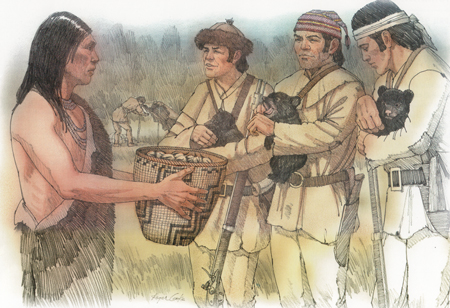At Provision Camp near present Washougal, Washington, Nathaniel Pryor brings in the last of the elk jerky. Lewis says it is too wet and must be jerked again. Three ‘pett’ bear cubs are brought to camp and traded for wapato. In Philadelphia, Charles Willson Peale reports on Lewis’s pronghorn specimens that arrived there recently.
More About the Multnomah
by Yellowstone Public Radio[1]Originally aired weekdays by Yellowstone Public Radio during the Bicentennial observance of 2003-2006. Narrated by Hal Hansen. Scripts by Whit Hansen and Ed Jacobson. Produced by Leni Holliman. © … Continue reading
Re-drying Meat
we Sent Sergt. Ordway and a party to assist Sergt. Pryor in bringing in the meat of four Elk which he had dryed. at 1 P. M the party returned with the meat. it had been so illy dryed that we feared it would not keep. we therefore directed it to be cut thinner and redryed over a fire this evening
—Meriwether Lewis
Three Pet Bear Cubs
Gass returned with Collins and Windsor they had not succeeded in killing the female bear tho’ they brought the three cubs with them. the Indians who visited us today fancyed these petts and gave us wappetoe [Wapato] in exchange for them.
—Meriwether Lewis
Ticks and Mosquitoes
the tick has made it’s appearance it is the Same with those of the Atlantic States. the Musquetors [Mosquitoes] have also appeared, but are not yet much troublesom.—
—William Clark
Fertile Soils
The Country on either Side is fertile, the bottom on the South Side is wide and inter sperced with Small ponds in which the nativs gather their Wappato . . . . the Country on the N. Side from a fiew Miles above this place as low down as the enterance of Cah-wah-na-ki-ooks River rises to the hight generally of 150 or 200 feet is tolerably leavel, thickly timbered with Fir and White Cedar. the Soil of the richest quallity.
—William Clark
Sitka Spruce, Fir No. 1
we measured a fallen tree of fir No. 1 which was 318 feet including the stump which was about 6 feet high. this tree was only about 3 ½ feet in diameter.
—Meriwether Lewis
Peale’s Skins
Museum April 5th. 1806.
Dear Sir [Thomas Jefferson]
The Skins of the several [pronghorn] Antilopes was so badly managed in the Skining, and also so much eaten by Dermests, that it was with much difficulty I could mount one of them, but being so interesting an Animal, I conceived it was better to have one even in bad condition, than to let it be wanting in the Museum, and should no description and plate have yet been made of this American Antilope, it may be acceptable to the public to give one in the American Philosophical [Society] transactions, I have therefore made the enclosed drawing.
CW Peale[2]Letters of the Lewis and Clark Expedition with Related Documents: 1783-1854, 2nd ed., ed. Donald Jackson (Urbana: University of Illinois Press, 1978), 301.
Weather Diary
State of weather at rise
Wind at rise
State of the weather at 4 P.M. Wind at 4 P.M. River cloudy after rain S W cloudy after fair & cloudy S W fallen 2 ½ in. rain but slight, air colder than usual this morning—6th this is the most perfectly fair day that we have seen for a Some time musquetoes troublesome this evening the cottonwood has put fourth its leaves and begin to assume a green appearance at a distance. the sweet willow has not yet generaly birst it’s budscales while the leaves of the red and broad leafed willow are of some size; it appears to be me to be the most backward in vegetating of all the willows. the narrow leafed willow is not found below tide water on this river.—
—Meriwether Lewis[3]To assist the reader of this web page, the date column is omitted, the “State of the Columbia River” columns have been merged, and some abbreviations have been spelled out.
Notes
| ↑1 | Originally aired weekdays by Yellowstone Public Radio during the Bicentennial observance of 2003-2006. Narrated by Hal Hansen. Scripts by Whit Hansen and Ed Jacobson. Produced by Leni Holliman. © 2003 by Yellowstone Public Radio. |
|---|---|
| ↑2 | Letters of the Lewis and Clark Expedition with Related Documents: 1783-1854, 2nd ed., ed. Donald Jackson (Urbana: University of Illinois Press, 1978), 301. |
| ↑3 | To assist the reader of this web page, the date column is omitted, the “State of the Columbia River” columns have been merged, and some abbreviations have been spelled out. |

